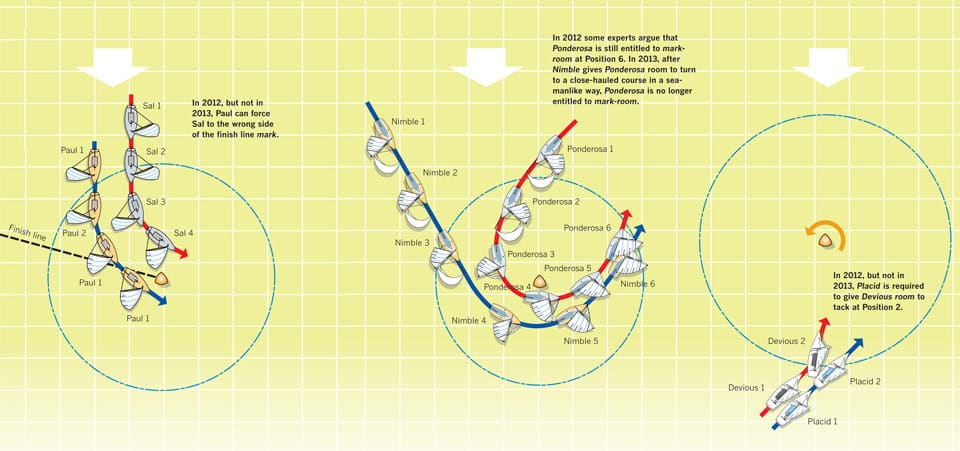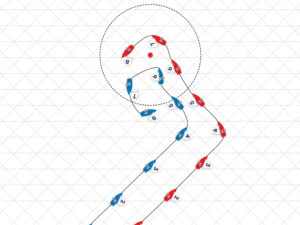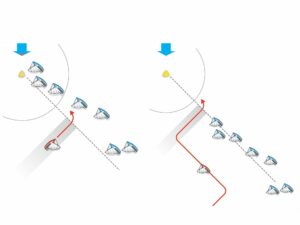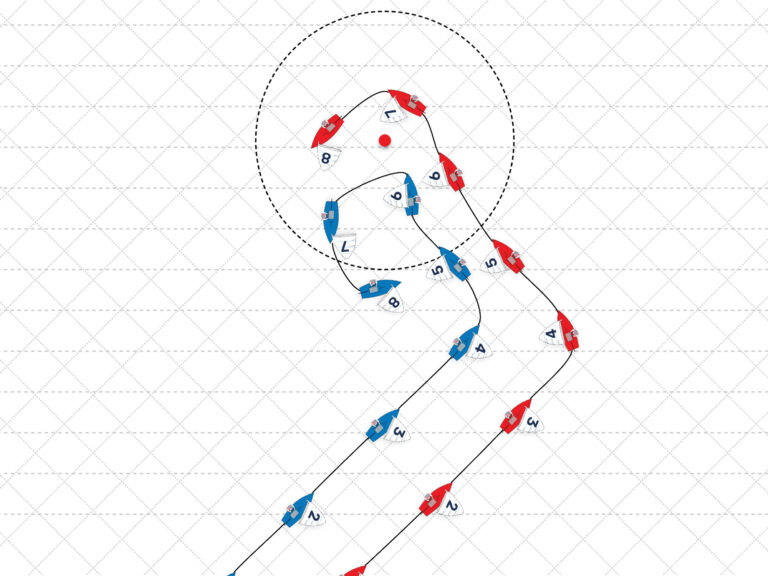
Mark room changes
As it always does immediately following an Olympics, the International Sailing Federation has issued a revised edition of The Racing Rules of Sailing. The new rules take effect on Jan. 1, 2013, unless sailing instructions for a series begun in 2012 state that the 2012 rules will continue to apply until the end of that series.
There are quite a few changes, but competitors will find that very few changes affect the “game” they play. I believe that in the last four years more knowledgeable and thoughtful people have been working together to make our rules clearer and fairer than ever before. ISAF and most active sailing countries have training and certification programs for protest and race committees. All those programs teach the rules, and thoughtful students in those programs join competitors in making suggestions for improvements to the rules. The quality of the discussion during ISAF Racing Rules Committee meetings has never been higher during the 20-plus years that I’ve been a member. And, of course, today’s electronic communications makes the work of all these individuals really easy.
ISAF has made available a new annotated rulebook to help sailors and officials understand the reasons for each significant change in the 2013 rulebook. It is available for viewing at sailingworld.com/1212newrules.
Over the next few issues in this space, I will discuss the noteworthy 2013 changes, beginning this month with the definition Mark-Room. The old and the new definition are below. The changes in this definition are, in my opinion, the most significant changes in the 2013 rulebook.
Mark-Room
2009-2012: Room for a boat to sail to the mark, and then room to sail her proper course while at the mark. However, mark-room does not include room to tack unless the boat is overlapped to windward and on the inside of the boat required to give mark-room.
2013-2016: Room for a boat to leave a mark on the required side. Also,
(a) room to sail to the mark when her proper course is to sail close to it, and
(b) room to round the mark as necessary to sail the course.
However, mark-room for a boat does not include room to tack unless she is overlapped inside and to windward of the boat required to give mark-room and she would be fetching the mark after her tack.
The objective of the definition Mark-Room, together with Rule 18, is to enable orderly, fair, and damage-free mark rounding of each mark of the course set by the race committee.
Both the old and the new definition use the phrase “room to sail to the mark.” A recent ISAF case based on a US Sailing appeal interprets “room to sail to the mark” to be “space to sail in a seamanlike way to a position close to, and on the required side of, the mark.” The old definition did not mention the required side of the mark; the new definition makes it clear that a boat entitled to mark-room is always entitled to room to leave the mark on the required side, i.e., the side specified in the course description.
However, the new definition grants a boat room to sail to the mark only when her proper course is to sail close to the mark. This limitation on room to sail to the mark has been introduced because the old definition could be gamed as shown in the first diagram, which shows two Lasers, sailed by Paul and Sal, running on opposite tacks and approaching a finish line mark to be left to port. Surfing conditions exist. At the zone, Paul is clear ahead of Sal and, therefore, entitled to mark-room. Paul’s proper course (the course he would sail to finish as soon as possible if Sal were not present) is to sail straight for the line. Just after Paul reaches the zone, Sal surfs into a position alongside Paul and it looks to Paul as if she might surf ahead of him. Under the 2012 rules, Paul is entitled to sail directly to the mark even if he breaks Rule 10 (see 2012 Rule 18.5(a)). By doing so, Paul forces Sal to the wrong side of the mark (Position 4).
Several competitors, including some team racers, wrote that they thought this gave Paul a much more powerful position than he deserved. Therefore, in 2013, a boat entitled to mark-room is entitled to room to sail to the mark only when her proper course is to sail close to it. At almost all rounding marks, the proper course for all boats is sail close to the mark. The only marks at which the situation shown in the first diagram is likely to occur are finish line marks.
Competitors and judges discovered three problems, two of them severe, with the phrase “room to sail her proper course while at the mark.”
Problem 1: For decades before 2009, an inside keep clear boat entitled to mark-room was only entitled to space for a seamanlike rounding and not a proper-course or a “tactical” rounding. Only an inside, right-of-way boat was entitled to take more space than needed for a seamanlike rounding. That changed when the 2009-2012 rules gave all inside boats the right sail their proper course while at the mark. Initially, many sailors did not spot this change. Later, when they finally did, they did not like it. They felt the 2009 definition gave too much power to the boat entitled to mark-room. The new definition restores the pre-2009 balance of powers by entitling an inside keep clear boat only to space for a seamanlike rounding.
Problem 2: It turned out that the word “at,” even though it’s a two-letter word, isn’t simple or clear. A great debate broke out over when a boat was no longer entitled to mark room, i.e., when she was no longer “at the mark.” Many competitors and judges thought that a boat was no longer “at the mark” when it was astern of her. However, boats often leave a mark astern well before they have completed their proper-course rounding of it.
The second diagram illustrates both problem (1) and (2). In a light-air PHRF race, Nimble and Ponderosa were rounding the leeward mark, with Ponderosa on the inside entitled to mark-room. Nimble is light, easily accelerated and easily turned. Ponderosa is heavier and slower to accelerate and turn. At Position 6, after both boats had left the mark astern but were still in the zone, there was contact. Ponderosa argued that, in the absence of Nimble, her proper course at Position 6 was to sail a close reach in order to build speed while making a gradual turn from a downwind course up to closehauled. For that reason, she claimed that at Position 6 she had not yet completed her proper-course rounding of the mark and was still entitled to mark-room. Nimble argued that, because the mark was astern, Rule 18.2 no longer applied, and Ponderosa, the windward boat, was required to keep clear under Rule 11. There were two distinct camps within the rules community—those who thought Ponderosa broke Rule 11 and those who thought Nimble broke Rule 18.2(b). In 2013, Ponderosa will be entitled to room for a seamanlike maneuver to round the mark as necessary to sail the course, i.e., as necessary to round onto a closehauled course. She will no longer be entitled to room to make a proper-course rounding. So, in 2013, before Position 6, Ponderosa must round up to close-hauled and, at Position 6, keep clear of Nimble.
Problem 3: Mark roundings are not as simple as the old definition suggests. Boats don’t always sail to a mark and then round it. Sometimes they sail to it, begin to round, and are then set back by current and must sail to it again. In 2013, unlike 2012, a boat that has sailed to the mark and begun to round would, if set back by current, be entitled to room to sail to the mark again.
The last sentence of the definition has been changed so that, in 2013, an inside overlapped boat is entitled to room to tack only if she would be fetching the mark after her tack. The third diagram shows how the last sentence of the 2012 definition can play out. Under it, Devious is entitled to room to tack at Position 2, even though Placid is giving her plenty of room to sail to the mark. If the contact shown in the diagram occurred in 2012, the rules would require that Placid be disqualified for not giving Devious room to tack at Position 2. In 2013, Devious would be in the wrong.









